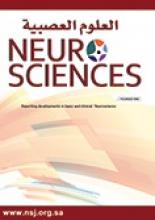Research ArticleOriginal Article
Open Access
Patients reasons for obtaining psychotropic medications without a prescription at retail pharmacies in Central Saudi Arabia
Fahad D. Alosaimi, Fay S. Alruwais, Fadah A. Alanazi, Ghaida A. Alabidi, Nadia A. Aljomah and Nuha S. Alsalameh
Neurosciences Journal October 2016, 21 (4) 338-344; DOI: https://doi.org/10.17712/nsj.2016.4.20160245
Fahad D. Alosaimi
From the Department of Psychiatry (Alosaimi), King Saud University Medical City, and from the College of Medicine (Alruwais, Alanazi, Alabidi, Aljomah, Alsalameh), King Saud University, Riyadh. Kingdom of Saudi Arabia
MDFay S. Alruwais
From the Department of Psychiatry (Alosaimi), King Saud University Medical City, and from the College of Medicine (Alruwais, Alanazi, Alabidi, Aljomah, Alsalameh), King Saud University, Riyadh. Kingdom of Saudi Arabia
Medical studentFadah A. Alanazi
From the Department of Psychiatry (Alosaimi), King Saud University Medical City, and from the College of Medicine (Alruwais, Alanazi, Alabidi, Aljomah, Alsalameh), King Saud University, Riyadh. Kingdom of Saudi Arabia
Medical studentGhaida A. Alabidi
From the Department of Psychiatry (Alosaimi), King Saud University Medical City, and from the College of Medicine (Alruwais, Alanazi, Alabidi, Aljomah, Alsalameh), King Saud University, Riyadh. Kingdom of Saudi Arabia
Medical studentNadia A. Aljomah
From the Department of Psychiatry (Alosaimi), King Saud University Medical City, and from the College of Medicine (Alruwais, Alanazi, Alabidi, Aljomah, Alsalameh), King Saud University, Riyadh. Kingdom of Saudi Arabia
Medical studentNuha S. Alsalameh
From the Department of Psychiatry (Alosaimi), King Saud University Medical City, and from the College of Medicine (Alruwais, Alanazi, Alabidi, Aljomah, Alsalameh), King Saud University, Riyadh. Kingdom of Saudi Arabia
Medical student
References
- ↵
- Ohayon MM,
- Lader MH
- ↵
- Wiechers IR,
- Leslie DL,
- Rosenheck RA
- ↵
- Sawalha AF
- ↵
- Bin Abdulhak AA,
- Altannir MA,
- Almansor MA,
- Almohaya MS,
- Onazi AS,
- Marei MA,
- et al.
- ↵
- Al-Mohamadi A,
- Badr A,
- Bin Mahfouz L,
- Samargandi D,
- Al Ahdal A
- ↵
- Al-Sayed AA,
- Al-Rashoudi AH,
- Al-Eisa AA,
- Addar AM,
- Al-Hargan AH,
- Al-Jerian AA,
- et al.
- ↵
- Chang CM,
- Wu EC,
- Chen CY,
- Wu KY,
- Liang HY,
- Chau YL,
- et al.
- ↵
- Ravera S,
- van Rein N,
- de Gier JJ,
- de Jong-van den Berg LT
- ↵
- Malekshahi T,
- Tioleco N,
- Ahmed N,
- Campbell AN,
- Haller D
- ↵
- Schifano F
- ↵
- Williams LJ,
- Pasco JA,
- Stuart AL,
- Jacka FN,
- Brennan SL,
- Dobbins AG,
- et al.
- ↵
- Wadsworth EJ,
- Moss SC,
- Simpson SA,
- Smith AP
- ↵
- Food and Drug Administration
- ↵
- Brooks JO,
- Hoblyn JC
- Van Strien AM,
- Koek HL,
- van Marum RJ,
- Emmelot-Vonk MH
- ↵
- Huybrechts KF,
- Rothman KJ,
- Silliman RA,
- Brookhart MA,
- Schneeweiss S
- ↵
- Abay SM,
- Amelo W
- ↵
- Kroenke K,
- Spitzer RL,
- Williams JBW
- ↵
- Manea L,
- Gilbody S,
- McMillan D
- ↵
- Spitzer RL,
- Kroenke K,
- Williams JB,
- Löwe B
- ↵
- Food and Drug Administration
- ↵
- Jiang HY,
- Chen HZ,
- Hu XJ,
- Yu ZH,
- Yang W,
- Deng M,
- et al.
- ↵
- Mortensen JK,
- Larsson H,
- Johnsen SP,
- Andersen G
- ↵
- Buckley NA,
- Dawson AH,
- Isbister GK
- ↵
- Rummel-Kluge C,
- Komossa K,
- Schwarz S,
- Hunger H,
- Schmid F,
- Lobos CA,
- et al.
- ↵
- De Hert M,
- Detraux J,
- van Winkel R,
- Yu W,
- Correll CU
- ↵
- Bostwick JR,
- Guthrie SK,
- Ellingrod VL
- ↵
- Belvederi Murri M,
- Guaglianone A,
- Bugliani M,
- Calcagno P,
- Respino M,
- Serafini G,
- et al.
- ↵
- Wu CS,
- Tsai YT,
- Tsai HJ
- ↵
- Ray WA,
- Chung CP,
- Murray KT,
- Hall K,
- Stein CM
- ↵
- Drew L
- ↵
- Wong J,
- Delva N
- ↵
- Ronaldson KJ,
- Fitzgerald PB,
- McNeil JJ
- ↵
- Schifano F
- ↵
- Olfson M,
- King M,
- Schoenbaum M
- ↵
- Murphy Y,
- Wilson E,
- Goldner EM,
- Fischer B
- ↵
- Ministry of Health. Formularly drug list
- ↵
- Yousef AMM,
- Al-Bakri AG,
- Bustanji Y,
- Wazaify M
- ↵
- Balamurugan E,
- Ganesh K
- ↵
- Jalilian F,
- Hazavehei SM,
- Vahidinia AA,
- Jalilian M,
- Moghimbeigi A
- ↵
- Al-Qadhi W,
- Ur Rahman S,
- Ferwana MS,
- Abdulmajeed IA
- ↵
- Al-Shehri SZ,
- Sabra AA,
- Taha AZ,
- Khamis AH,
- Hafez AS
- ↵
- Council of Cooperative Health Insurance
- ↵
- Alosaimi FD,
- Alshehri Y,
- Alfraih I,
- Alghamdi A,
- Aldahash S,
- Alkhuzayem H,
- et al.
- ↵
- Trenque T,
- Piednoir D,
- Frances C,
- Millart H,
- Germain ML
In this issue
Patients reasons for obtaining psychotropic medications without a prescription at retail pharmacies in Central Saudi Arabia
Fahad D. Alosaimi, Fay S. Alruwais, Fadah A. Alanazi, Ghaida A. Alabidi, Nadia A. Aljomah, Nuha S. Alsalameh
Neurosciences Journal Oct 2016, 21 (4) 338-344; DOI: 10.17712/nsj.2016.4.20160245
Patients reasons for obtaining psychotropic medications without a prescription at retail pharmacies in Central Saudi Arabia
Fahad D. Alosaimi, Fay S. Alruwais, Fadah A. Alanazi, Ghaida A. Alabidi, Nadia A. Aljomah, Nuha S. Alsalameh
Neurosciences Journal Oct 2016, 21 (4) 338-344; DOI: 10.17712/nsj.2016.4.20160245
Jump to section
Related Articles
- No related articles found.
Cited By...
- No citing articles found.





